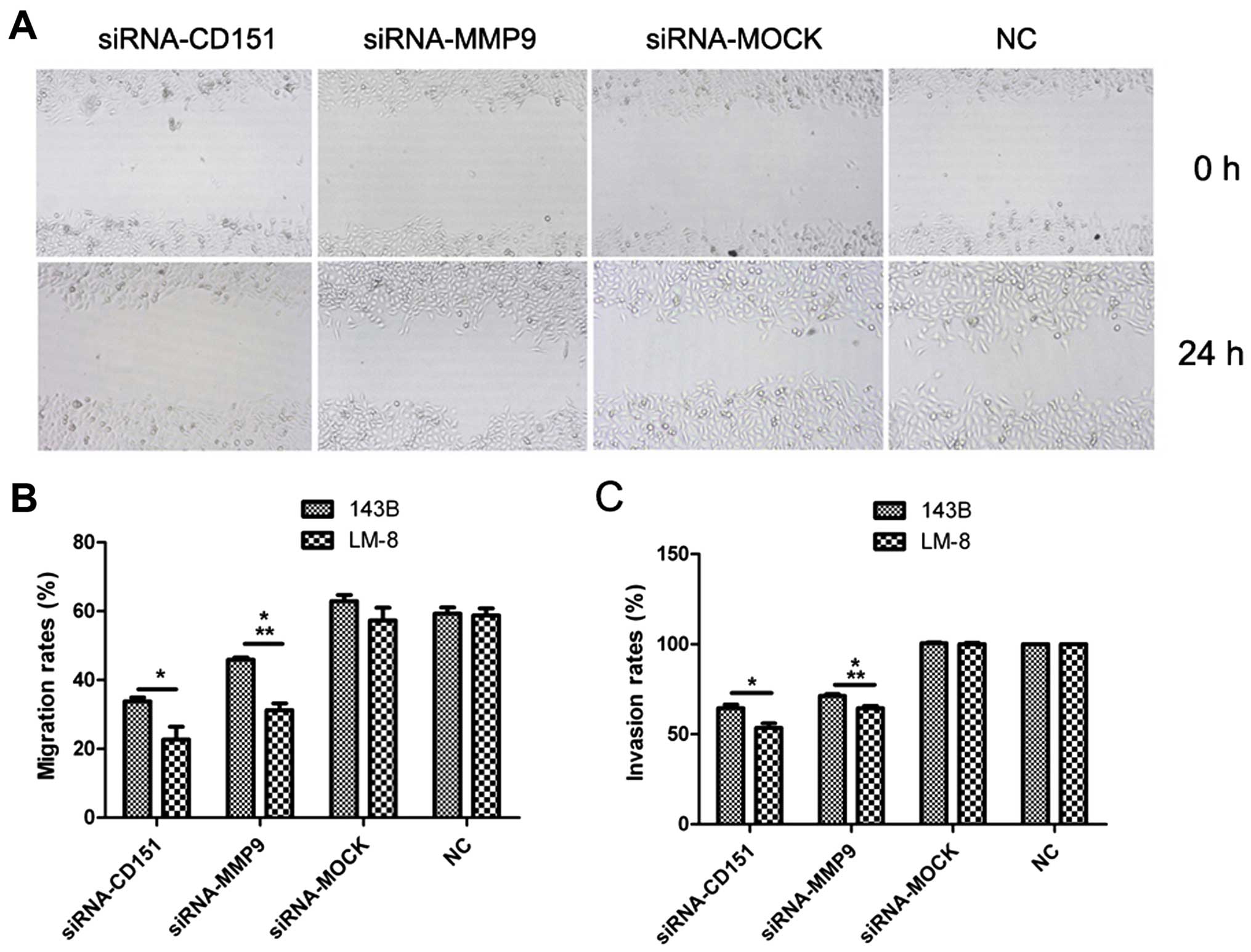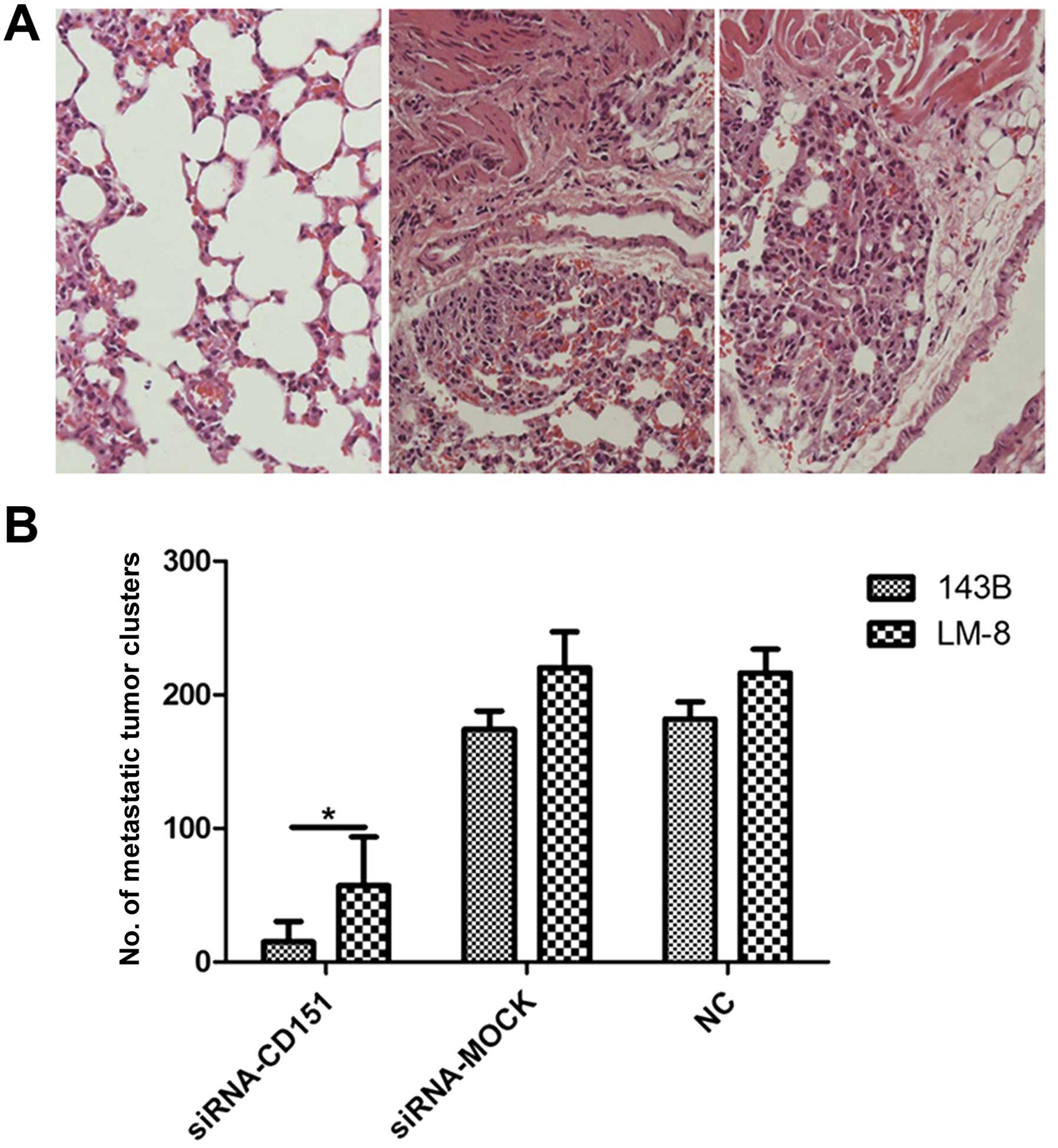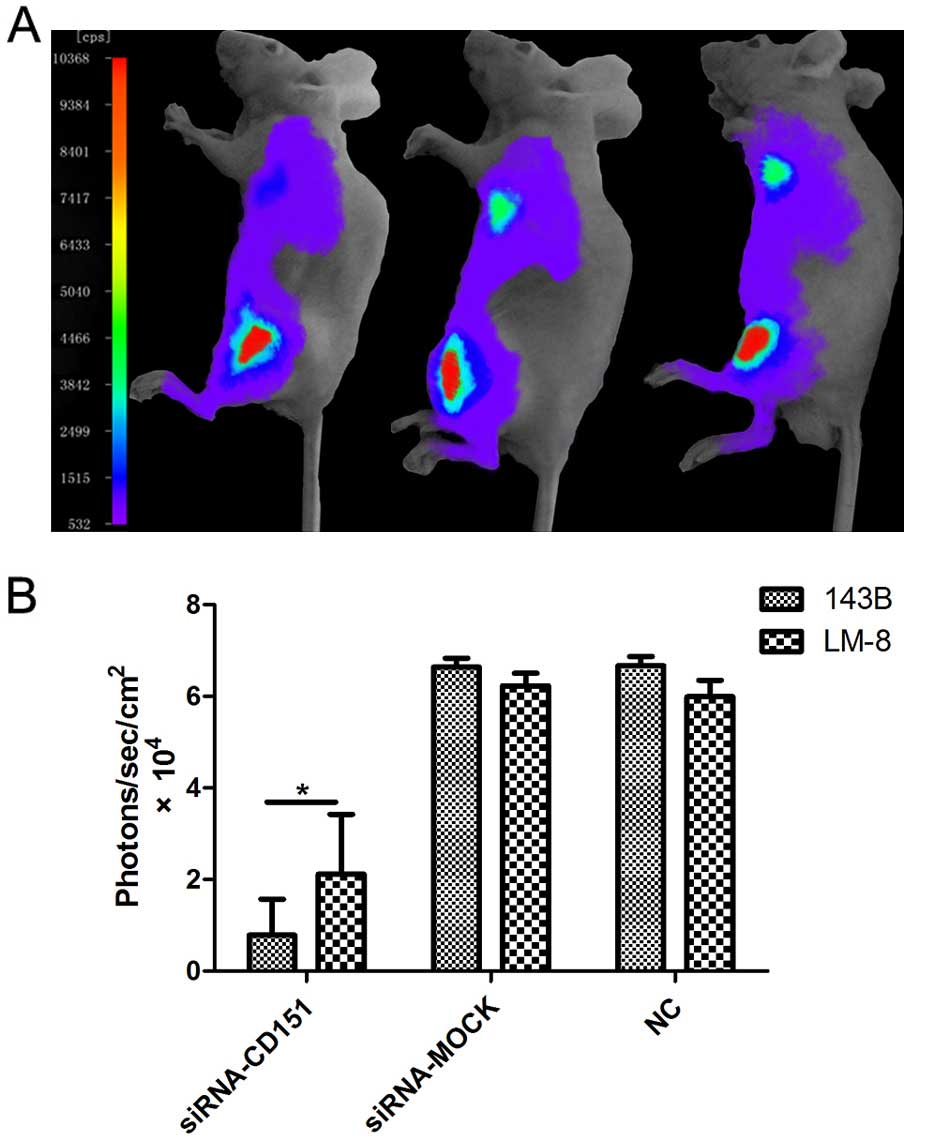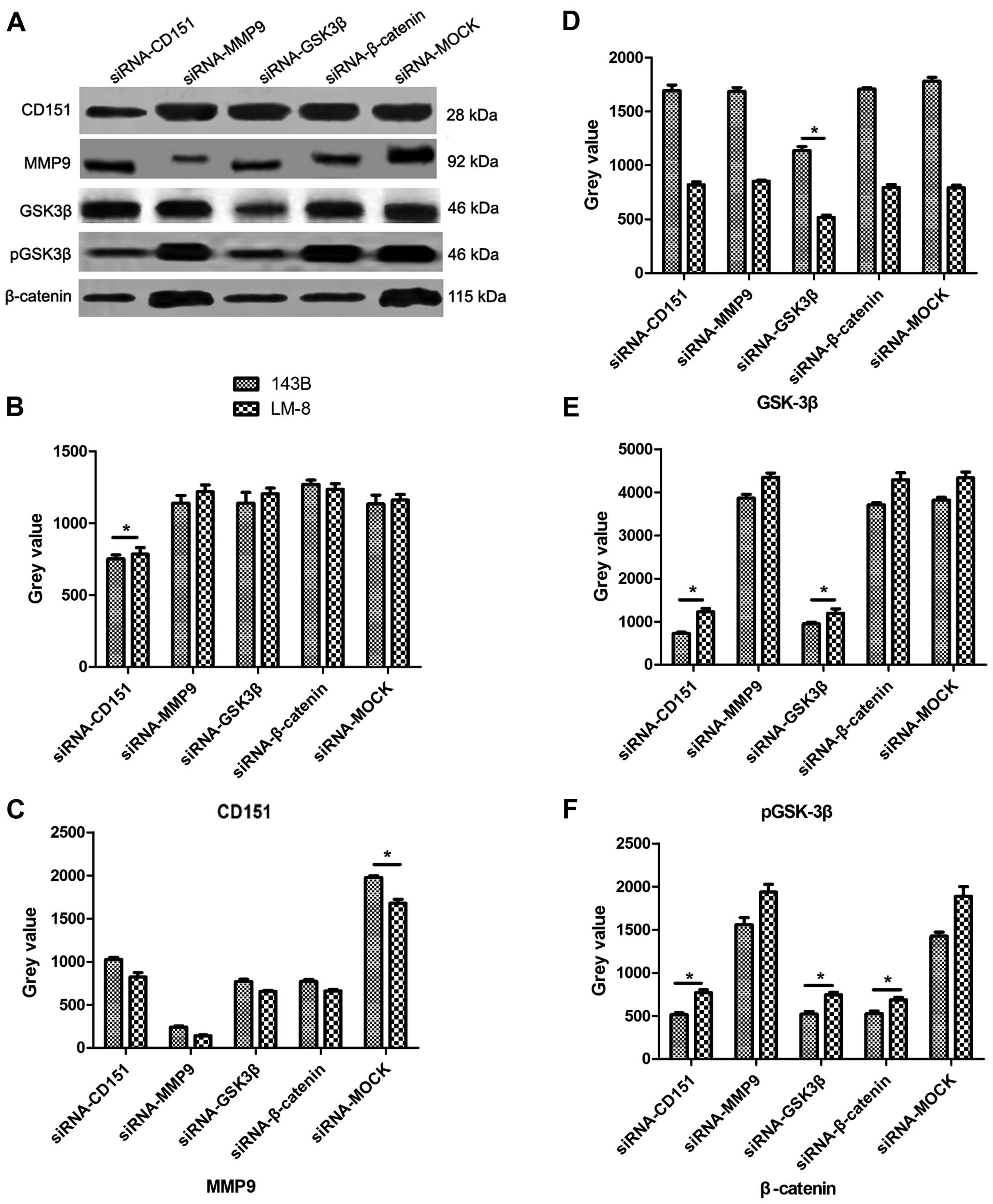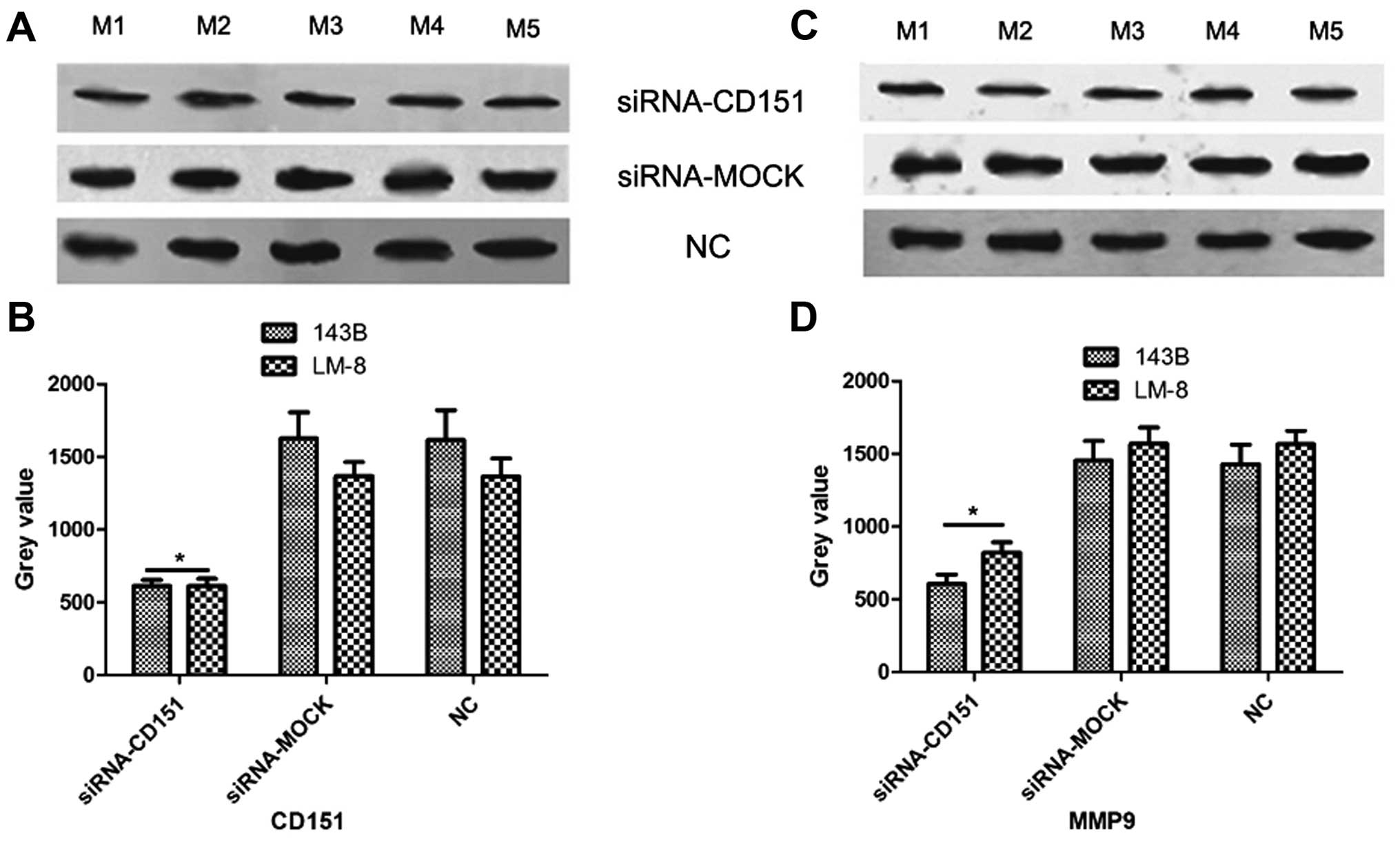CD151 knockdown inhibits osteosarcoma metastasis through the GSK-3β/β-catenin/MMP9 pathway
- Authors:
- Published online on: December 24, 2015 https://doi.org/10.3892/or.2015.4517
- Pages: 1764-1770
Abstract
Introduction
Osteosarcoma (OS) is one of the most common primary bone malignancies in childhood and adolescents and it has a high early metastatic propensity. In the past several decades, the 5-year overall survival rate for OS patients has increased due to the application of intensive neoadjuvant chemotherapy and surgery. However, the overall survival rate has plateaued at 60% and the prognosis remains unsatisfactory for those with pulmonary metastasis at diagnosis, who have 5-year survival rates of less than 30% (1). Therefore, new therapeutic strategies are being sought for this lethal malignancy and gene therapy appears to be a promising approach. Targeting specific genes is a proven strategy (2) and gene therapy approaches with some specific targets, such as tumor necrosis factor α (TNF-α) (3) and endothelin A receptor (ETAR) (4), have been evaluated as potential antimetastatic treatments for OS. However, to date no gene therapy approach has been validated for clinical application and further investigation is needed to identify new targets.
CD151 is a member of the tetraspanins family, which is considered to comprise molecular facilitators (5). CD151 is involved in several pathological activities of tumors, including growth (6), angiogenesis (7) and invasion/metastasis (8). Several lines of evidence indicate that the primary role of CD151 in tumor progression is to facilitate metastasis (8–11), and it is suggested that CD151 is involved in modulating the metastasis of various sarcomas, such as fibrosarcoma (12), however, the role and mechanism of CD151 in promoting OS metastasis remain vague. In our previous study (13), the results of proteomic and immunohistochemical analyses confirmed the upregulation of CD151 in OS and suggested CD151 to be a key regulator of the progression of OS. In addition, protein-protein interaction network analysis demonstrated a potential relationship between CD151 and β-catenin, which is the central molecule in the canonical Wnt (Wnt) signaling pathway and is modulated by glycogen synthase kinase 3β (GSK-3β) (14). However the function and mechanism of CD151 in OS metastasis have not been clarified.
Following the results of our previous study (13), the anti-metastatic effect of the downregulation of CD151 was further evaluated using small interfering RNA (siRNA) in vitro and in vivo, and the molecular mechanism of CD151 in OS metastasis was investigated using a highly metastatic human OS cell line.
Materials and methods
Cell line and animals
Two highly metastatic OS cell lines, human 143B and mouse LM-8 (kindly gifted by Professor Zhengdong Cai, First Hospital of Shanghai, Shanghai, China) (15), were cultured in Dulbecco's modified Eagle's medium (DMEM) (Sigma-Aldrich, St. Louis, MO, USA) supplemented with 10% (v/v) fetal bovine serum (FBS) (Gibco, Grand Island, NY, USA), and maintained at 37°C in a 5% CO2 incubator (Thermo Scientific, Waltham, MA, USA). Female BALB/c nude mice, 4–5 weeks old were obtained from Vital River Company, Beijing, and were fed under specific pathogen free conditions. Water-soluble vitamin C was added into the drinking water to aid the healthy growth of the mice. All experimental procedures were performed in accordance with the guidelines for laboratory animals established by China Medical University of Animal Care and Use Committee.
Antibodies
Primary anti-CD151 and matrix metalloproteinase 9 (MMP9) antibodies were purchased from AbD Serotec (Oxford, UK). Anti-GSK-3β, anti-phosphorylated GSK-3β (pGSK-3β, activated GSK-3β) and β-catenin antibodies were obtained from Sigma-Aldrich. HRP-conjugated rabbit anti-mouse IgG secondary antibody was purchased from Sigma-Aldrich.
Establishment of luciferase-expressing OS cells
The luciferase-expressing OS cells were prepared for bioluminescent imaging assay. Stable transfections were carried out with Lipofectamine® 2000 in 6-well dishes according to the manufacturer's instructions (Invitrogen Life Technologies, Carlsbad, CA, USA). After a 48-h transfection, a stable luciferase-expressing clone was selected by limited dilution to create a Luc-143B or Luc-LM-8 cell line. Briefly, 1/10, 1/30 and 1/100 of the cells were digested and diluted into 10 ml of completed medium, and then every dilution of cells were seeded into 96-well plates and grown in medium containing G418 (600 µg/ml). After several days, the single cell clones were transferred into T25 flasks. After proliferation, the cell lines with the highest luciferase activity were selected using a luciferase detection kit (Beyotime) and EnVision imaging (PerkinElmer).
Transfection of siRNAs
The siRNA sequences targeting CD151, MMP9, GSK-3β and β-catenin were purchased from Shanghai GenePharma (Shanghai, China). A non-targeting scrambled sequence, siRNA-MOCK was used as a control. Transfection of the siRNAs was performed using Lipofectamine® 2000 (Invitrogen) according to the manufacturer's instructions. The levels of target gene expression of the stably transfected clones were validated by quantitative real-time polymerase chain reaction (data not shown).
Wound healing assay
Wound healing migration assays were performed as previously described (16). Subconfluent cells were treated with siRNA-CD151, siRNA-MMP9, siRNA-MOCK and 0.9% NaCl as the normal control (NC). After 72 h, the cells were trypsinized, counted and re-plated in 1% (v/v) FBS complete media in 6-well dishes containing a sterile metal 3-pronged cross (0.75-mm thick) to create a consistent gap in the monolayer of cells. At 12 h after plating, the cross was removed. Bright-field images of the field adjacent to the left center arm of the cross were captured at 0 and 24 h after removing the cross to assess cell migration across the gap. These assays were carried out in triplicate. The cell migration rate was calculated as: (width 0 h − width 24 h)/width 24 h × 100.
Matrigel® invasion assay
Matrigel® invasion assays were performed as previously described (17). Briefly, subconfluent tumor cells were infected with siRNA-CD151, siRNA-MMP9, siRNA-MOCK and 0.9% NaCl as NC and assayed at 72 h. The concentration of the invading cells was determined using CellTiter-Glo® viability assay (Promega, Madison, WI, USA) at room temperature and the light absorbance of the medium was measured by a Bio-Rad 680 microplate reader (Bio-Rad, Hercules, CA, USA) after 10 min. The assay was performed in triplicate. The cell invasion rate was calculated as: (value of sample/value of NC) × 100.
Orthotopic xenograft models
Orthotopic xenograft models were performed as previously described (16). The highly metastatic 143B and LM-8 OS cells, transfected with luciferase were harvested and prepared for injection (1.5×106 cells/injection) into the left flanks of BALB/c nude mice. Five mice were used in each group. When the tumor diameters reached ~0.5 cm, the mice were randomly divided into 3 groups and siRNA-CD151, siRNA-MOCK and 0.9% NaCl as NC, respectively, were intratumorally injected once every 3 days. At 4 weeks after the implantation of OS cells, animals were sacrificed and lungs were harvested for evaluation.
Animal histological evaluation
Histological evaluation was performed as previously described (16). All samples were assigned a number and the treatment group was blinded. The harvested lungs were fixed with 10% (w/v) formalin, embedded in paraffin, serially sectioned and stained with hematoxylin and eosin. Evaluation of the histologic slides was performed by a trained pathologist in a blinded manner.
Bioluminescent imaging
BALB/c nude mice transplanted with luciferase-expressing OS cells underwent non-invasive whole-body imaging using the bioluminescence imaging system (LB983 NC100; Berthold) at 4 weeks. The mice were injected with 125 mg/kg D-luciferin solution intraperitoneally before being anaesthetized via intraperitoneal injection of pentobarbital (50 mg/kg) for the procedure. Ten or 12 min after injection, the images were acquired for 0.5–300 sec. The photon emission from the animals was captured and quantitated using Indigo software (Indigo Software, Belgium).
Immunoprecipitation
Proteins were extracted from cells and tumor tissues with RIPA buffer in the presence of a protease inhibitor, and the total protein concentration was determined using a BCA protein assay kit (Thermo Scientific, Rockford, IL, USA). The supernatants were collected after centrifuging and primary antibodies (5 µg/ml) of the targeted genes pre-conjugated with magnetic beads (50 µl; Invitrogen) were added to the supernatant and incubated with gentle agitation, respectively. After washing with phosphate-buffered saline, proteins bound to the beads were eluted. The samples were loaded for sodium dodecyl sulfate-polyacrylamide gel electrophoresis and transferred to polyvinylidene fluoride membranes. The membranes were blocked and incubated with the primary antibodies overnight at 4°C. Then, the membranes were incubated with secondary antibodies at room temperature for 1 h, and the signal was detected using a Tenon GIS Gel image system (Shanghai, China).
Statistical analysis
Statistical analysis was performed with SPSS version 16.0 software (SPSS, Inc., Chicago, IL, USA). Data were presented as the mean ± standard error of the mean (SEM). Student's t-test and one-way analysis of variance were used for statistical comparisons among groups. P<0.05 was considered to indicate a significant difference.
Results
Inhibition of migration and invasion in vitro
In order to assess the effects of siRNA-CD151 and siRNA-MMP9 on the migration and invasion of the highly metastatic OS cells, migration rates were evaluated by wound healing assay and invasion was evaluated by Matrigel® invasion assay. The results of the wound healing assay (Fig. 1A and B) showed that the migration rates were decreased by 45% for the 143B cells and 60% for the LM-8 cells following siRNA-CD151 transfection, and 25% for the 143B cells and 45% for the LM-8 cells following siRNA-MMP9 transfection, compared with the rates of the NC group (P<0.01). Inhibition of the migration rate following siRNA-CD151 transfection was higher than that following siRNA-MMP9 transfection (P<0.01). According to the results of the Matrigel invasion assay (Fig. 1C), the invasion rates were decreased by 36% for 143B cells and 47% for the LM-8 cells following siRNA-CD151 transfection, and 29% for the 143B cells and 36% for LM-8 cells following siRNA-MMP9 transfection, compared with those of the NC group (P<0.01). The invasion rate following siRNA-CD151 transfection was lower than that following siRNA-MMP9 transfection (P<0.01).
Inhibition of metastasis by siRNA-CD151 in vivo
CD151 was selected as a target for tumor therapy due to its role in facilitating metastasis in tumors. As described above, results from wound healing and Matrigel assays demonstrated that the migration and invasion of the OS cells transfected with siRNA-CD151 were significantly inhibited, compared with those of the siRNA-MOCK and NC groups. Inhibition of metastasis by silencing CD151 in vivo supported the data obtained in vitro. The in vivo results indicated that tumor metastasis rates and the numbers of pulmonary tumor clusters were significantly decreased in all siRNA-CD151-treated mice, compared with those of the controls (Fig. 2). The rate of pulmonary metastasis was 100% (5/5) in both the siRNA-MOCK and NC groups, whereas it was 20% (1/5) in the siRNA-CD151 group for 143B cells and 40% (2/5) for LM-8 cells transplantation. The numbers of metastatic tumor clusters per mouse were significantly different between the siRNA-CD151 and the siRNA-MOCK and NC groups, respectively (P<0.01). Moreover, the bioluminescent imaging assay demonstrated similar results (Fig. 3). After 4 weeks of transplantation, each of the BALB/c nude mice injected with luciferase-expressing OS cells demonstrated a strong and similar detectable signal over the left flanks, whereas the detected signal at the metastatic site of the lungs demonstrated significant difference between groups. Signals at the site of lungs in all of the BALB/c nude mice injected with siRNA-MOCK and NC were similar and moderate, demonstrating a 100% pulmonary metastatic rate, whereas in the BALB/c nude mice injected with siRNA-CD151, the pulmonary metastatic rate was decreased (20% for 143B and 40% for LM-8 cells), which was confirmed with a positive but minimal bioluminescent signal over the site (Fig. 3A). In addition, statistical analysis demonstrated that the signals at the lungs in the siRNA-CD151 group were significantly lower than those in the siRNA-MOCK and NC groups (Fig. 3B; P<0.01).
Antimetastatic mechanism of CD151
The findings of our previous study (13) suggest that CD151 may interact with β-catenin, which is the central molecule in the Wnt signaling pathway and regulate the expression of various genes including MMP9 (18). Moreover, CD151 has been found to modulate tumor metastasis through regulating MMP9 expression (19). We hypothesized that CD151 knockdown inhibits OS metastasis through regulation of MMP9 expression and therefore we scrutinized the molecular mechanism by IP assay. The protein was extracted from the OS cells after transfections with targeted siRNAs and evaluated by IP assay (Fig. 4). After silencing CD151, the phosphorylation level of GSK-3β (pGSK-3β) and the expression levels of β-catenin and MMP9 were significantly reduced, compared with those of the siRNA-MOCK-treated cells. Then, we silenced MMP9 expression and found that except for MMP9, none of the targeted genes were downregulated by siRNA-MMP9. GSK-3β modulates β-catenin expression (20), and the results from the IP assay demonstrated that the expression levels of GSK-3β, β-catenin, MMP9 and pGSK-3β were significantly reduced by siRNA-GSK-3β, while CD151 expression remained stable. As MMP9 is a downstream target gene of the Wnt signaling pathway, all of the target genes were evaluated after silencing β-catenin, and the results showed that β-catenin and MMP9 expression levels were significantly reduced, while CD151, GSK-3β and pGSK-3β expression remained unchanged. The data obtained from the in vivo experiments (Fig. 5) consolidated the results obtained in vitro. In the siRNA-CD151 group in vivo, the expression levels of CD151 and MMP9 were significantly reduced compared with those of the siRNA-MOCK and NC groups.
Discussion
Osteosarcoma (OS) is a primary bone malignancy with a high early metastatic propensity. Despite some progress in therapies over the past several decades, the prognosis of patients with pulmonary metastasis remains unsatisfactory (1). Therefore, it is of great importance to investigate possible molecular mechanisms and develop antimetastatic strategies for OS. In the present study, we employed two highly metastatic OS cell lines, human 143B and mouse LM-8, along with siRNA to investigate the molecular mechanisms and antimetastatic effects of CD151 in vitro and in vivo. Tetraspanin CD151 is considered as a 'facilitator' (5,21) and has been suggested to have regulatory roles at different stages of cancer progression, such as tumorigenesis (22), angiogenesis (23) and particularly metastasis (8–11). In our previous study, by comparing the plasma membrane proteome between OS and osteoblasts and the expression of potential OS-related genes between OS tissues and adjacent non-tumorous tissues, CD151 was validated to be upregulated in OS. In addition, the expression of CD151 in different cell lines was compared with the IP assay, presenting similar results (data not shown). Furthermore, according to bioinformatic analysis, CD151 was suggested to be a key molecule regulating the progression of OS and a therapeutic target (13). However, the exact function(s) of CD151 in promoting OS remains vague.
As it is of great importance to investigate antimetastatic strategies for OS, in the present study for the first time we investigated the role of CD151 in regulating OS metastasis. Migration through the surrounding extracellular matrix and invasion of the basement membrane are important steps for metastasis of tumor cells, and CD151 has been reported to regulate migration and invasion of tumor cells (24,25). Wound healing and Matrigel assays were used to investigate the migration and invasion abilities, respectively, of the OS cells in vitro. The results showed that after CD151 was knocked down in vitro using siRNA, the migration and invasion rates of the OS cells were both decreased, respectively. Furthermore, the antimetastasis effects of CD151 knockdown in OS in vivo was evaluated using an orthotopic xenograft model of nude mice. After intratumoral administration of CD151 siRNA for 4 weeks, the pulmonary metastatic rate and the mean number of pulmonary metastatic clusters per mouse were decreased. These values were significantly greater than those of the siRNA-MOCK and NC groups. Moreover, the bioluminescent imaging results demonstrated a similar metastatic inhibition effect with CD151 knockdown. Thus, we concluded that CD151 knockdown inhibited OS metastasis.
A number of lines of evidence have suggested that CD151 modulates metastasis through different molecular mechanisms, including the regulation of integrin-mediated cellular behaviors (26–28), growth factor-mediated interplay between tumors and their microenvironments (10), MMP expression and activation (29,30) and signal transduction (21). The results of our previous study (13) suggested that β-catenin, which is a multifunctional molecule and the key effector of the Wnt signaling pathway (31,32), was mechanistically involved in the regulation of OS progression by CD151. The Wnt signaling pathway has been implicated in regulating several stages of OS progression, including tumorigenesis, tumor growth and metastasis (33,34). It has been reported that β-catenin accumulation in the cytoplasm is a common occurrence in OS (35) and this process is modulated by upstream molecules, including GSK-3β (32). Our findings showed that CD151 modulated GSK-3β activation (36). Thus, the relationships among CD151, β-catenin and GSK-3β were evaluated by siRNA treatments. The results showed that CD151 knockdown reduced the expression levels of pGSK-3β and β-catenin, and that GSK-3β knockdown reduced β-catenin expression. These findings showed that CD151 modulated β-catenin expression via GSK-3β activation. Moreover, recent studies demonstrated that CD151 can modulate MMP9 expression through the FAK/p38/MAPK/JNK/c-Jun and the PI3K/Akt/GSK-3β/Snail pathways (19,36), which is a downstream target of Wnt (37) and has been suggested to modulate OS metastasis (38). Our in vitro and in vivo results indicated that CD151 knockdown reduced MMP9 expression in OS cells and xenograft model mice. Since MMP9 was shown to be a target gene of Wnt (37), MMP9 expression was evaluated by knockdown of GSK-3β and β-catenin, and the results showed that MMP9 expression was increased when GSK-3β or β-catenin expression was reduced. Therefore, based on our results, we conclude that CD151 knockdown reduces MMP9 expression via GSK-3β/β-catenin signaling in highly metastatic OS cells.
In conclusion, OS is one of the most common primary bone malignancies with a high early metastatic propensity and our findings suggested that in highly metastatic OS cells, CD151 knockdown inhibited their migration, invasion and metastasis through the GSK-3β/β-catenin/MMP9 signaling pathway. These findings suggest that CD151 could be considered a potential antimetastatic target for the treatment of OS, although further investigation should be made before clinical application.
Abbreviations:
|
OS |
osteosarcoma |
|
siRNA |
small interfering RNA |
|
MMP9 |
matrix metalloproteinase 9 |
|
GSK-3β |
glycogen synthase kinase 3 |
|
NC |
normal control |
References
|
Allison DC, Carney SC, Ahlmann ER, Hendifar A, Chawla S, Fedenko A, Angeles C and Menendez LR: A meta-analysis of osteosarcoma outcomes in the modern medical era. Sarcoma. 2012:7048722012. View Article : Google Scholar : PubMed/NCBI | |
|
Yang J and Zhang W: New molecular insights into osteosarcoma targeted therapy. Curr Opin Oncol. 25:398–406. 2013. View Article : Google Scholar : PubMed/NCBI | |
|
Kato H, Wakabayashi H, Naito Y, Kato S, Nakagawa T, Matsumine A and Sudo A: Anti-tumor necrosis factor therapy inhibits lung metastasis in an osteosarcoma cell line. Oncology. 88:139–146. 2015. | |
|
Li Y, Liao Q, Li K, Zhong D, Weng X and Mi M: Knockdown of endothelin A receptor expression inhibits osteosarcoma pulmonary metastasis in an orthotopic xenograft mouse model. Mol Med Rep. 5:1391–1395. 2012.PubMed/NCBI | |
|
Zöller M: Tetraspanins: Push and pull in suppressing and promoting metastasis. Nat Rev Cancer. 9:40–55. 2009. View Article : Google Scholar | |
|
Li P, Zeng H, Qin J, Zou Y, Peng D, Zuo H and Liu Z: Effects of tetraspanin CD151 inhibition on A549 human lung adenocarcinoma cells. Mol Med Rep. 11:1258–1265. 2015. | |
|
Peng D, Zuo H, Liu Z, Qin J, Zhou Y, Li P, Wang D, Zeng H and Zhang XA: The tetraspanin CD151-ARSA mutant inhibits angiogenesis via the YRSL sequence. Mol Med Rep. 7:836–842. 2013.PubMed/NCBI | |
|
Copeland BT, Bowman MJ and Ashman LK: Genetic ablation of the tetraspanin CD151 reduces spontaneous metastatic spread of prostate cancer in the TRAMP model. Mol Cancer Res. 11:95–105. 2013. View Article : Google Scholar | |
|
Zijlstra A, Lewis J, Degryse B, Stuhlmann H and Quigley JP: The inhibition of tumor cell intravasation and subsequent metastasis via regulation of in vivo tumor cell motility by the tetraspanin CD151. Cancer Cell. 13:221–234. 2008. View Article : Google Scholar : PubMed/NCBI | |
|
Sadej R, Romanska H, Kavanagh D, Baldwin G, Takahashi T, Kalia N and Berditchevski F: Tetraspanin CD151 regulates transforming growth factor beta signaling: Implication in tumor metastasis. Cancer Res. 70:6059–6070. 2010. View Article : Google Scholar : PubMed/NCBI | |
|
Takeda Y, Li Q, Kazarov AR, Epardaud M, Elpek K, Turley SJ and Hemler ME: Diminished metastasis in tetraspanin CD151-knockout mice. Blood. 118:464–472. 2011. View Article : Google Scholar : PubMed/NCBI | |
|
Sadej R, Grudowska A, Turczyk L, Kordek R and Romanska HM: CD151 in cancer progression and metastasis: A complex scenario. Lab Invest. 94:41–51. 2014. View Article : Google Scholar | |
|
Zhang Z, Zhang L, Hua Y, Jia X, Li J, Hu S, Peng X, Yang P, Sun M, Ma F, et al: Comparative proteomic analysis of plasma membrane proteins between human osteosarcoma and normal osteoblastic cell lines. BMC Cancer. 10:2062010. View Article : Google Scholar : PubMed/NCBI | |
|
Hoeppner LH, Secreto FJ and Westendorf JJ: Wnt signaling as a therapeutic target for bone diseases. Expert Opin Ther Targets. 13:485–496. 2009. View Article : Google Scholar : PubMed/NCBI | |
|
Luu HH, Kang Q, Park JK, Si W, Luo Q, Jiang W, Yin H, Montag AG, Simon MA, Peabody TD, et al: An orthotopic model of human osteosarcoma growth and spontaneous pulmonary metastasis. Clin Exp Metastasis. 22:319–329. 2005. View Article : Google Scholar : PubMed/NCBI | |
|
Luo X, Sharff KA, Chen J, He TC and Luu HH: S100A6 expression and function in human osteosarcoma. Clin Orthop Relat Res. 466:2060–2070. 2008. View Article : Google Scholar : PubMed/NCBI | |
|
Su Y, Luo X, He BC, Wang Y, Chen L, Zuo GW, Liu B, Bi Y, Huang J, Zhu GH, et al: Establishment and characterization of a new highly metastatic human osteosarcoma cell line. Clin Exp Metastasis. 26:599–610. 2009. View Article : Google Scholar : PubMed/NCBI | |
|
Liu Z, Rebowe RE, Wang Z, Li Y, Wang Z, DePaolo JS, Guo J, Qian C and Liu W: KIF3a promotes proliferation and invasion via Wnt signaling in advanced prostate cancer. Mol Cancer Res. 12:491–503. 2014. View Article : Google Scholar : PubMed/NCBI | |
|
Hong IK, Jin YJ, Byun HJ, Jeoung DI, Kim YM and Lee H: Homophilic interactions of tetraspanin CD151 up-regulate motility and matrix metalloproteinase-9 expression of human melanoma cells through adhesion-dependent c-Jun activation signaling pathways. J Biol Chem. 281:24279–24292. 2006. View Article : Google Scholar : PubMed/NCBI | |
|
Li M, Zhou W, Yuan R, Chen L, Liu T, Huang D, Hao L, Xie Y and Shao J: ROCK2 promotes HCC proliferation by CEBPD inhibition through phospho-GSK3β/β-catenin signaling. FEBS Lett. 589:1018–1025. 2015. View Article : Google Scholar : PubMed/NCBI | |
|
Hong IK, Jeoung DI, Ha KS, Kim YM and Lee H: Tetraspanin CD151 stimulates adhesion-dependent activation of Ras, Rac, and Cdc42 by facilitating molecular association between β1 integrins and small GTPases. J Biol Chem. 287:32027–32039. 2012. View Article : Google Scholar : PubMed/NCBI | |
|
Roselli S, Kahl RG, Copeland BT, Naylor MJ, Weidenhofer J, Muller WJ and Ashman LK: Deletion of Cd151 reduces mammary tumorigenesis in the MMTV/PyMT mouse model. BMC Cancer. 14:5092014. View Article : Google Scholar : PubMed/NCBI | |
|
Takeda Y, Kazarov AR, Butterfield CE, Hopkins BD, Benjamin LE, Kaipainen A and Hemler ME: Deletion of tetraspanin Cd151 results in decreased pathologic angiogenesis in vivo and in vitro. Blood. 109:1524–1532. 2007. View Article : Google Scholar | |
|
Palmer TD, Martínez CH, Vasquez C, Hebron KE, Jones-Paris C, Arnold SA, Chan SM, Chalasani V, Gomez-Lemus JA, Williams AK, et al: Integrin-free tetraspanin CD151 can inhibit tumor cell motility upon clustering and is a clinical indicator of prostate cancer progression. Cancer Res. 74:173–187. 2014. View Article : Google Scholar : | |
|
Ranjan A, Bane SM and Kalraiya RD: Glycosylation of the laminin receptor (α3β1) regulates its association with tetraspanin CD151: Impact on cell spreading, motility, degradation and invasion of basement membrane by tumor cells. Exp Cell Res. 322:249–264. 2014. View Article : Google Scholar : PubMed/NCBI | |
|
Fei Y, Wang J, Liu W, Zuo H, Qin J, Wang D, Zeng H and Liu Z: CD151 promotes cancer cell metastasis via integrins α3β1 and α6β1 in vitro. Mol Med Rep. 6:1226–1230. 2012.PubMed/NCBI | |
|
Deng X, Li Q, Hoff J, Novak M, Yang H, Jin H, Erfani SF, Sharma C, Zhou P, Rabinovitz I, et al: Integrin-associated CD151 drives ErbB2-evoked mammary tumor onset and metastasis. Neoplasia. 14:678–689. 2012. View Article : Google Scholar : PubMed/NCBI | |
|
Gustafson-Wagner E and Stipp CS: The CD9/CD81 tetraspanin complex and tetraspanin CD151 regulate α3β1 integrin-dependent tumor cell behaviors by overlapping but distinct mechanisms. PLoS One. 8:e618342013. View Article : Google Scholar | |
|
Shiomi T, Inoki I, Kataoka F, Ohtsuka T, Hashimoto G, Nemori R and Okada Y: Pericellular activation of proMMP-7 (promatrilysin-1) through interaction with CD151. Lab Invest. 85:1489–1506. 2005.PubMed/NCBI | |
|
Yue S, Mu W and Zöller M: Tspan8 and CD151 promote metastasis by distinct mechanisms. Eur J Cancer. 49:2934–2948. 2013. View Article : Google Scholar : PubMed/NCBI | |
|
Wang Y, Li YP, Paulson C, Shao JZ, Zhang X, Wu M and Chen W: Wnt and the Wnt signaling pathway in bone development and disease. Front Biosci. 19:379–407. 2014. View Article : Google Scholar | |
|
Valenta T, Hausmann G and Basler K: The many faces and functions of β-catenin. EMBO J. 31:2714–2736. 2012. View Article : Google Scholar : PubMed/NCBI | |
|
Lin CH, Guo Y, Ghaffar S, McQueen P, Pourmorady J, Christ A, Rooney K, Ji T, Eskander R, Zi X, et al: Dkk-3, a secreted wnt antagonist, suppresses tumorigenic potential and pulmonary metastasis in osteosarcoma. Sarcoma. 2013:1475412013. View Article : Google Scholar : PubMed/NCBI | |
|
Ji T, Guo Y, Kim K, McQueen P, Ghaffar S, Christ A, Lin C, Eskander R, Zi X and Hoang BH: Neuropilin-2 expression is inhibited by secreted Wnt antagonists and its down-regulation is associated with reduced tumor growth and metastasis in osteosarcoma. Mol Cancer. 14:862015. View Article : Google Scholar : PubMed/NCBI | |
|
Haydon RC, Deyrup A, Ishikawa A, Heck R, Jiang W, Zhou L, Feng T, King D, Cheng H, Breyer B, et al: Cytoplasmic and/or nuclear accumulation of the beta-catenin protein is a frequent event in human osteosarcoma. Int J Cancer. 102:338–342. 2002. View Article : Google Scholar : PubMed/NCBI | |
|
Shi GM, Ke AW, Zhou J, Wang XY, Xu Y, Ding ZB, Devbhandari RP, Huang XY, Qiu SJ, Shi YH, et al: CD151 modulates expression of matrix metalloproteinase 9 and promotes neoangiogenesis and progression of hepatocellular carcinoma. Hepatology. 52:183–196. 2010. View Article : Google Scholar : PubMed/NCBI | |
|
Kwon M, Lee SJ, Wang Y, Rybak Y, Luna A, Reddy S, Adem A, Beaty BT, Condeelis JS and Libutti SK: Filamin A interacting protein 1-like inhibits WNT signaling and MMP expression to suppress cancer cell invasion and metastasis. Int J Cancer. 135:48–60. 2014. View Article : Google Scholar : | |
|
Liu T, Zhou W, Zhang F, Shi G, Teng H, Xiao J and Wang Y: Knockdown of IRX2 inhibits osteosarcoma cell proliferation and invasion by the AKT/MMP9 signaling pathway. Mol Med Rep. 10:169–174. 2014.PubMed/NCBI |



